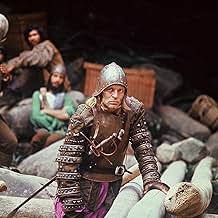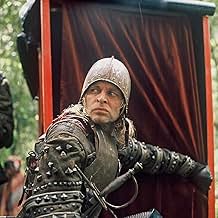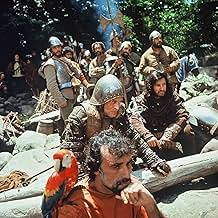No século XVI, o cruel e louco Don Lope de Aguirre lidera uma expedição espanhola em busca de El Dorado.No século XVI, o cruel e louco Don Lope de Aguirre lidera uma expedição espanhola em busca de El Dorado.No século XVI, o cruel e louco Don Lope de Aguirre lidera uma expedição espanhola em busca de El Dorado.
- Direção
- Roteirista
- Artistas
- Prêmios
- 4 vitórias e 3 indicações no total
Claus Biederstaedt
- Brother Gaspar de Carvajal
- (narração)
- (não creditado)
Lothar Blumhagen
- Don Pedro de Ursua
- (narração)
- (não creditado)
Heinz Theo Branding
- Don Fernando de Guzman
- (narração)
- (não creditado)
Christian Brückner
- Balthasar
- (narração)
- (não creditado)
Avaliações em destaque
A Spanish expedition is sent out to travel deep into the jungle and find the legendary city of El Dorado and recover its gold for the throne of Spain. Quickly the expedition gets into trouble and leader Don Pedro de Ursua decides that they must turn back. However to do this is not an option to Don Lope de Aguirre, who leads a violent rebellion, culling those loyal to Ursua and officially breaking off ties with Spain. The group continue down the river in search of their goal but conditions are hard and it is only the increasingly unrealistic aims of Aguirre that drives them onwards.
In both the film and the making of the film this is best sold as a medieval Apocalypse Now as it has a great collection of stories behind it while also being an interesting journey into the mouth of madness. The "making of" is told better other places than I can do here so I shan't bother, but suffice to say that at times the film feels like Herzog is just watching his cast to see what happens and not just following his characters. The plot sees them gradually fall from the pomp and civility that they start the film with and this is no surprise, but the manner in which it happens is still interesting and engaging. Some viewers may find it going where they expect it to, but this should not surprise anyone and it shouldn't stop the majority of people enjoying the journey.
Herzog's direction is strong throughout. He does well with what was a very difficult shoot and he gets plenty of strong shots out of it all of which still stand up as being impressive by today's standards. His direction of actors may not have been quite as good but the performances are still very good. Kinski is very strong in the lead role and, whether acting or not, he is totally convincing as he loses touch with reality. The support are all good, although Kinski is obviously where the picture is.
Overall an impressive film that is more worthwhile watching because of the stories behind it. The narrative may be simple and obvious enough but it is still very engaging as a journey or rather descent. Is maybe praised a little bit too highly by some but is a fascinating film regardless.
In both the film and the making of the film this is best sold as a medieval Apocalypse Now as it has a great collection of stories behind it while also being an interesting journey into the mouth of madness. The "making of" is told better other places than I can do here so I shan't bother, but suffice to say that at times the film feels like Herzog is just watching his cast to see what happens and not just following his characters. The plot sees them gradually fall from the pomp and civility that they start the film with and this is no surprise, but the manner in which it happens is still interesting and engaging. Some viewers may find it going where they expect it to, but this should not surprise anyone and it shouldn't stop the majority of people enjoying the journey.
Herzog's direction is strong throughout. He does well with what was a very difficult shoot and he gets plenty of strong shots out of it all of which still stand up as being impressive by today's standards. His direction of actors may not have been quite as good but the performances are still very good. Kinski is very strong in the lead role and, whether acting or not, he is totally convincing as he loses touch with reality. The support are all good, although Kinski is obviously where the picture is.
Overall an impressive film that is more worthwhile watching because of the stories behind it. The narrative may be simple and obvious enough but it is still very engaging as a journey or rather descent. Is maybe praised a little bit too highly by some but is a fascinating film regardless.
Stunning, dreamlike film documents (in a somewhat documentary style), the story of Don Lope de Aguirre (Klaus Kinski), who leads a group of Spanish conquistadors into the depths of the jungle in search for El Dorado, the mythical city of gold. Beautiful cinematography and locations place the viewer into the heart of the jungle, where they witness firsthand Aguirre's descent into madness. Continually interesting and exciting, it features some of the greatest images ever committed to film, most notably the opening and closing shots of the movie.
AGUIRRE: THE WRATH OF GOD (Werner Herzog - West Germany 1972).
Herzog's daring and unconventional approach in film-making is something very few filmmakers can match. Due to the incredible hardships while filming on location in the Amazonian jungle, the myth surrounding AGUIRRE has almost outgrown the virtues of the film itself and over the years it has become an almost integral part when (re)viewing this film, even more so since Herzog's documentary MY BEST FIEND (1999) was released about his relationship with "best enemy" and star in many of his films, Klaus Kinski.
A mesmerizing exploration of human obsession based on the diaries of Gaspar de Varvajal, a monk who accompanied Gonzalez Pizarro (half-brother of the brutal conqueror of the Incas) and died during the expedition, the film chronicles Pizarro's 1560 Peruvian expedition in search of the legendary city of gold, El Dorado. When the expedition is faltering by the difficult terrain, Pizarro decides to send a small party ahead to determine if exploration should continue. Though Don Pedro de Ursua (Ruy Guerra) is put in charge, he is soon challenged by the ambitious fanatical Aguirre (Klaus Kinski), who against all odds wants the journey to continue, with catastrophic consequences.
One of the key elements in Herzog's work is the use of landscape and the natural surroundings. The Amazonian jungle is a key third dimension in the film and really is a green hell, threatening and unforgiven. There's no romanticism in Herzog's view of nature. The continuing sounds of the running water and the birds are just as important for the story and the despair of Aguirre's men as the ambient electronic soundtrack by the German ensemble Popol Vuh, the ultimate modern and very German pioneers in electronic music, mixing choral chants with electronic samples and organ music. To me it is simply astonishing Herzog decided to use their in a film about 16th century Spanish explorers shot on location in the Amazon and somehow it works wonderfully, a perfect blend of image and sound. Hard to identify a very important element of the "natural soundtrack": what's the name of the bird that produces this whistling shriek, that is heard almost continuously in the background and is one of the most recognizable sounds of Neo-tropical rain forests? A Quetzal?
Klaus Kinski's performance is a perfect match for Aguirre's descent into madness, eerily resemblant to Kinski's own Mad Kraut persona and well-published rampant behavior on the set and his misconduct in general actually. Watching the film for the first time with audio commentary by Herzog and he revealed many things I never heard before. One of the strangest anecdotes is not really about the film itself but is, well..truly one of the most bizarre things I ever heard.
Before the shooting started, Herzog and his crew were boarding for the plane that would bring them from Lima to Cuzco when the airplane had some technical problems. Since the airline company in question already had two or three serious accidents not long before, they decided to wait and take the next plane. Repaired or not, the plane left off anyway and crashed in the Amazonian jungle with the only survivor a young German woman, Juliane Koepcke. After weeks she finally reached a remote Indian village, malnourished, an almost fatal larval infection, close to death. Later Herzog would make a documentary about this, JULIANES STURZ IN DEN DSCHUNGEL (English title: Wings of Hope) (2000). Besides the already astonishing, many times near-fatal accidents and Kinski's impossible madman behavior, this film seemed doomed from the start, like an old curse from the Incas.
For those less familiar with Herzog's work, FITZCARRALDO (1982), also by Herzog and shot under equally horrendous conditions in the Peruvian jungle, would make a good companion piece. For Herzog's relationship with Kinski there is the interesting documentary MEIN LIEBSTER FEIND (My best fiend) (1999).
Camera Obscura --- 10/10
Herzog's daring and unconventional approach in film-making is something very few filmmakers can match. Due to the incredible hardships while filming on location in the Amazonian jungle, the myth surrounding AGUIRRE has almost outgrown the virtues of the film itself and over the years it has become an almost integral part when (re)viewing this film, even more so since Herzog's documentary MY BEST FIEND (1999) was released about his relationship with "best enemy" and star in many of his films, Klaus Kinski.
A mesmerizing exploration of human obsession based on the diaries of Gaspar de Varvajal, a monk who accompanied Gonzalez Pizarro (half-brother of the brutal conqueror of the Incas) and died during the expedition, the film chronicles Pizarro's 1560 Peruvian expedition in search of the legendary city of gold, El Dorado. When the expedition is faltering by the difficult terrain, Pizarro decides to send a small party ahead to determine if exploration should continue. Though Don Pedro de Ursua (Ruy Guerra) is put in charge, he is soon challenged by the ambitious fanatical Aguirre (Klaus Kinski), who against all odds wants the journey to continue, with catastrophic consequences.
One of the key elements in Herzog's work is the use of landscape and the natural surroundings. The Amazonian jungle is a key third dimension in the film and really is a green hell, threatening and unforgiven. There's no romanticism in Herzog's view of nature. The continuing sounds of the running water and the birds are just as important for the story and the despair of Aguirre's men as the ambient electronic soundtrack by the German ensemble Popol Vuh, the ultimate modern and very German pioneers in electronic music, mixing choral chants with electronic samples and organ music. To me it is simply astonishing Herzog decided to use their in a film about 16th century Spanish explorers shot on location in the Amazon and somehow it works wonderfully, a perfect blend of image and sound. Hard to identify a very important element of the "natural soundtrack": what's the name of the bird that produces this whistling shriek, that is heard almost continuously in the background and is one of the most recognizable sounds of Neo-tropical rain forests? A Quetzal?
Klaus Kinski's performance is a perfect match for Aguirre's descent into madness, eerily resemblant to Kinski's own Mad Kraut persona and well-published rampant behavior on the set and his misconduct in general actually. Watching the film for the first time with audio commentary by Herzog and he revealed many things I never heard before. One of the strangest anecdotes is not really about the film itself but is, well..truly one of the most bizarre things I ever heard.
Before the shooting started, Herzog and his crew were boarding for the plane that would bring them from Lima to Cuzco when the airplane had some technical problems. Since the airline company in question already had two or three serious accidents not long before, they decided to wait and take the next plane. Repaired or not, the plane left off anyway and crashed in the Amazonian jungle with the only survivor a young German woman, Juliane Koepcke. After weeks she finally reached a remote Indian village, malnourished, an almost fatal larval infection, close to death. Later Herzog would make a documentary about this, JULIANES STURZ IN DEN DSCHUNGEL (English title: Wings of Hope) (2000). Besides the already astonishing, many times near-fatal accidents and Kinski's impossible madman behavior, this film seemed doomed from the start, like an old curse from the Incas.
For those less familiar with Herzog's work, FITZCARRALDO (1982), also by Herzog and shot under equally horrendous conditions in the Peruvian jungle, would make a good companion piece. For Herzog's relationship with Kinski there is the interesting documentary MEIN LIEBSTER FEIND (My best fiend) (1999).
Camera Obscura --- 10/10
... in his pursuit of the gold of El Dorado while exhibiting incestuous thoughts towards his daughter and a belief he is god - with a supporting cast of treason, mutiny, murder, slavery, cannibalism and monkeys: you consider yourself fortunate not to have been part of the Spanish, or indeed any countries ruthless empire building in the past.
You are however grateful, for the vision and inspirational insight brought to you by Werner Herzog, leaving you transfixed by the pioneers plight, surroundings (visual and audible), naivety and ignorance in their futile quest for immortality and riches. When you couple all this with the challenges of the films gestation, the time of its inception and the instability and unpredictable nature of Klaus Kinski; that it was ever birthed in the first instance turns it into a treasure worth discovering, or rediscovering if you've mislaid your ability to explore new cinematic horizons.
You are however grateful, for the vision and inspirational insight brought to you by Werner Herzog, leaving you transfixed by the pioneers plight, surroundings (visual and audible), naivety and ignorance in their futile quest for immortality and riches. When you couple all this with the challenges of the films gestation, the time of its inception and the instability and unpredictable nature of Klaus Kinski; that it was ever birthed in the first instance turns it into a treasure worth discovering, or rediscovering if you've mislaid your ability to explore new cinematic horizons.
This is neither the masterwork nor the garbage most people see in it. Sure, it has a lot of very strong points - Kinski's acting, a fascinating plot, the original settings, some good cinematography and an unforgettable closing scene. However, the movie seriously suffers from awkward cuts and terrible dramaturgy; and, worst of all, the stiff dialogues and the amateur-class acting of almost everybody besides Kinski (you will note both especially if you speak German) make some scenes unbearable. So all in all, while it may have the potential to be a really great movie, it delivers only sometimes, and in order to call it a masterpiece, you would have to be very generous and overlook many flaws ...
Você sabia?
- CuriosidadesDuring a particularly rowdy night of production, Klaus Kinski, irritated by the noise from a hut where cast and crew were playing cards, repeatedly fired with a Winchester rifle into it. One of the bullets took the tip of an unnamed extra's finger off. Werner Herzog immediately confiscated the weapon and it remains his property to this day.
- Erros de gravaçãoThe indigenous Peruvians wear clothes that were imported by Europeans in the 19th century.
- Citações
Don Lope de Aguirre: That man is a head taller than me. That may change.
- Versões alternativasThe early 2000's DVD release is missing the opening shot (after the text scroll) of the clouds parting to reveal the mountains. It simply opens on the shot following the line of people descending the narrow mountain trail. It also is missing the title credits over the river water. Earlier U.S. video versions were missing these titles as well, but kept the footage so that the film had several seemingly unmotivated long shots of the flowing water.
- ConexõesEdited into Spisok korabley (2008)
- Trilhas sonorasAguirre, Der Zorn Gottes (Lacrime Di Re)
Written by Florian Fricke
Performed by Popol Vuh
Published by Edition Intro Meisel
Courtesy of Gammarock Music
Principais escolhas
Faça login para avaliar e ver a lista de recomendações personalizadas
Detalhes
- Data de lançamento
- Países de origem
- Idiomas
- Também conhecido como
- Aguirre, la ira de Dios
- Locações de filme
- Huayna Picchu, Peru(mountain with stone stairway in the opening scene)
- Empresas de produção
- Consulte mais créditos da empresa na IMDbPro
Bilheteria
- Orçamento
- US$ 370.000 (estimativa)
- Faturamento bruto mundial
- US$ 37.794
Contribua para esta página
Sugerir uma alteração ou adicionar conteúdo ausente

Principal brecha
What is the Hindi language plot outline for Aguirre, a Cólera dos Deuses (1972)?
Responda






























